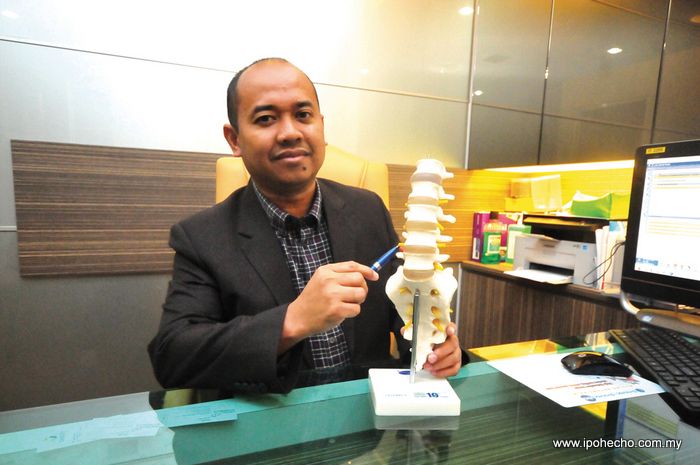

Ipoh Echo recently spoke to Dr Eskandar @ Zulkarnain Hassan, Resident Consultant Orthopaedic, Spine and Trauma of KPJ Ipoh Specialist Hospital about prolapsed intervertebral disc.


According to him, the prevalence of disc prolapse is highest between the ages of 30 to 50. Males have a higher incidence than females with the ratio of 2:1. However, only 2% to 3% of prolapsed discs are symptomatic. Thus, surgery is not the only treatment option in all prolapsed discs.
“Prolapsed disc or slipped disc is a term used interchangeably. Both refer to the damage of tissue absorbing the knocking in between the vertebra bones. The damage may range from a small tear with minimal bulge of disc to complete tear and extruded disc content,” said Dr Eskandar.
Causes
It commonly occurs when lifting weights without a proper spine posture or due to a fall, especially those on the buttocks.
Symptoms
The first important symptom of a prolapsed disc is a sudden snapping pain over the back and the person will be locked in one position due to severe pain. The person will not be able to stand up right due to the radicular pain to the back and leg. The symptoms may vary, from only a localised low back pain to pain radiating to the lower limbs. Pain in spinal claudication due to a prolapsed disc, numbness or weakness may also occur during walking or standing although no pain will be felt while at rest.


Complications
The worst complication from a prolapsed disc is known as cauda equina syndrome. It is considered an orthopaedic emergency. The patient is presented with all the described pain with inability to control bowel or bladder and complete numbness of the genitalia. The worrying part is that 80% of patients do not recover their normal bowel and bladder functions even after emergency surgery.
Treatments
Spinal injection with steroid has been practised for many years. It is simple, safe and effective in managing pain. There is a list of possible side effects related to steroid usage. However, if it is done by trained personnel and the after-injection precautions are practised, the side effect is minimal and the benefits of the procedure far outweigh the side effects.
The main objective of treatment is to alleviate pain. Thus the first line of treatment involves taking a combination of medications, including analgesics. Physiotherapy with the use of ultrasound, transcutaneous electrical nerve stimulation, traction system and heating may help to reduce the pain.
Failed optimum medication and physiotherapy require more aggressive treatment including epidural steroid or radio frequency ablation of disc (depends on what MRI results show).
The last option is by surgery: endoscopic discectomy. It is a minimally invasive surgery with an inch-size wound and recovery is fast. Most patients start to walk on the same day as the surgery.
For more information, call Dr Eskandar @ Zulkarnain Hassan of KPJ Ipoh Specialist Hospital at 05 240 8777 (Ext. 125).
Nantini


